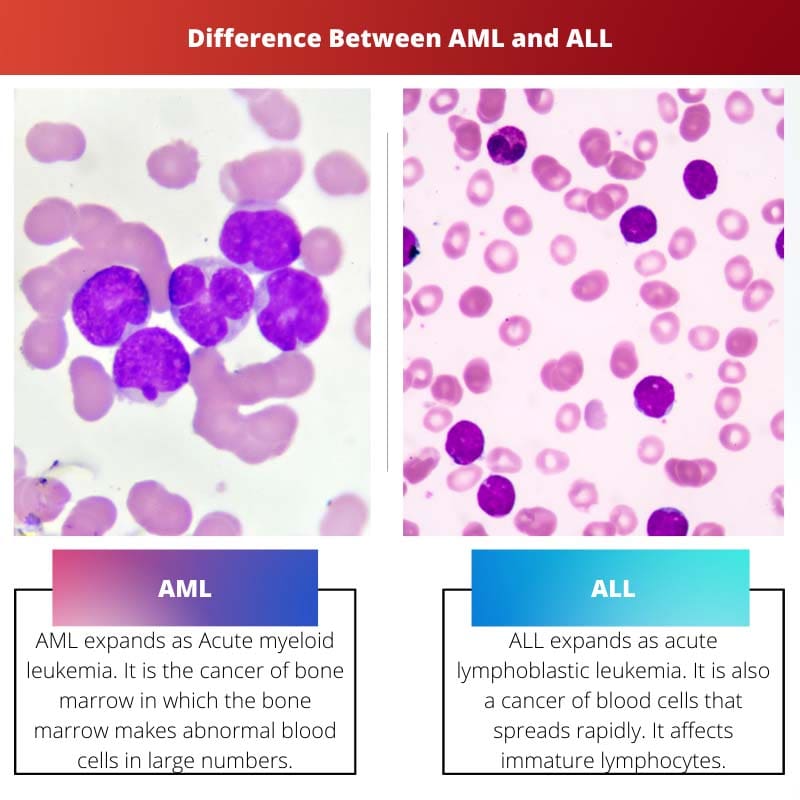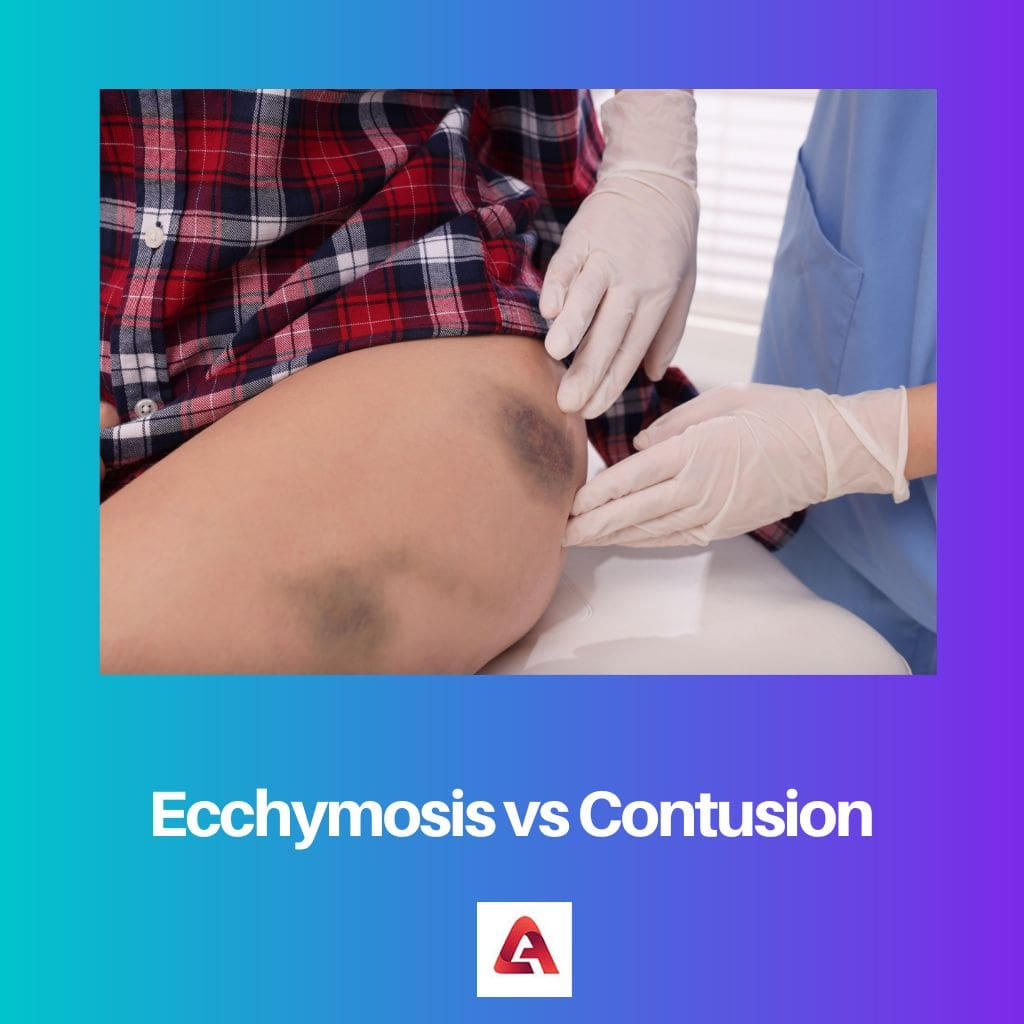Leukaemia is a type of cancer that affects the bone marrow cells which produce blood cells. Acute leukaemia is a severe condition, and it grows quickly.
Myeloblasts and Lymphocytes are the types of cells that are affected in AML and ALL. Myeloblasts are precursor White blood cells.
They divide and later differentiate into different types of WBCs like neutrophils, basophils, and eosinophils. Lymphocytes are a type of white blood cells.
There are two types of lymphocytes they are B lymphocytes and T lymphocytes.
Key Takeaways
- AML (Acute Myeloid Leukemia) originates in myeloid cells, while ALL (Acute Lymphoblastic Leukemia) develops in lymphoid cells.
- AML affects adults more commonly, whereas ALL is more prevalent in children.
- Treatment approaches vary, with AML requiring more aggressive therapies than ALL.
AML vs ALL
The difference between AML and ALL is that in AML, the production of myeloblasts, RBC and platelets is affected, but in ALL, the production of lymphocytes is affected. AML is the most common type of leukaemia occurring among adults, while ALL is common in children who are 2-10 years old. 40% of the people who are below 60 years recover from AML. The recovery percentage is 30% for ALL in people who are less than 30 years.

AML expands as Acute myeloid leukaemia. It is a cancer of bone marrow in which the bone marrow makes abnormal blood cells in large numbers.
Bone marrow is the interior soft tissue of the bone. This bone marrow is from where new blood cells are formed.
Since it affects the myeloid cells and progresses rapidly, the name acute myeloid leukaemia.
ALL expands as acute lymphoblastic leukaemia. It is also a cancer of blood cells that spreads rapidly. It affects immature lymphocytes.
It is a serious condition and, if untreated, can be fatal. It is very common among children and can be treated with proper medications.
It rarely occurs in adults for which there are very few chances of cure. It is caused due to mutation in the bone marrow cells.
Comparison Table
| Parameters of Comparison | AML | ALL |
|---|---|---|
| Abnormal Cells | RBC, Myeloblasts, and Platelets | Lymphoblasts |
| Expansion | Acute myeloid leukemia | Acute lymphoblastic leukemia |
| Diagnosis | The blood smear test, bone marrow biopsy, and Cell cytometry analysis. | Blood cell count and lumbar puncture to analyze spinal fluid. |
| Induction therapy | Chemotherapy | Chemotherapy |
| Consolidation therapy | High dose chemotherapy and hematopoietic cell therapy. | Multidrug chemotherapy, stem cell therapy, and hematopoietic cell therapy. |
| Survival rate | 29.5% | 69.9% |
What is AML?
Mutations in the genetic material cause AML. These mutations cause the bone marrow cells to produce progenitor blood cells that can develop into different blood cells in large numbers.
As a result of the overproduction of blood cells, these excessive blood cells accumulate and abrupt the functioning of normal healthy cells.
The real cause for the mutation causing AML is not known.
But, the risk factors include previous cancer treatments like radiation and chemotherapy, people who are over 60 years are more likely to get AML, and Men have the greatest probability of getting AML.
Exposure to radiation or carcinogenic chemicals like benzene increases the risk, smoking, genetic and other blood disorders can also increase the risk.
However, people with no risk factors can also develop AML. Some people with risk factors do not develop AML.
Early symptoms of AML are similar to the flu symptoms and symptoms of another common disease. But in later stages, the symptoms get severe, including fever, bone pain, lethargy, fatigue, pale skin, shortness of breath, frequent infections, swollen lymph nodes, unusual bleeding from the gums and nose, and easy bruising.
Due to abnormal WBC function, the body’s immune system is affected thus, the person becomes prone to infections.

What is ALL?
ALL is caused by mutations that arise in the DNA. This mutation affects the normal cell division and causes the cells to divide at a large rate.
In this case, the bone marrow produces the precursor for lymphocytes in large numbers, which then develop into leukemic cells called Lymphoblasts.
These cells disrupt the functioning of normal cells and the immune system.
Risk factors of ALL are genetic disorders like Downs syndrome, being male, exposure to radiation, and previous cancer treatments.
Infection with certain viruses like Epstein Barr virus or T-cell lymphoma virus can also lead to the development of ALL.
Symptoms include fever, night sweats, loss of appetite, stomach pain, and tiny red spots under the skin. ALL is most reported in children and older adults.
Doctors run diagnostic tests to confirm ALL. A blood count test is done to check the number of different blood cells.
A lumbar puncture is given to check if cancer has spread to the nervous system, and the spinal fluid is drawn and checked.
Induction chemotherapy is given initially, and multidrug chemotherapy is given as consolidation therapy to kill any remaining cancer cells.
Hematopoietic cell transplantation is also given as consolidation therapy.

Main Differences Between AML and ALL
- AML causes the bone marrow to produce a large number of myeloblasts, platelets, and red blood cells. But, in ALL lymphocytes, production is increased.
- Both AML and ALL are leukaemia, and the symptoms are more or less similar.
- AML is common among old people over 60, but ALL affects children aged 2-10 years and those over 60.
- The survival rate of a person with AML for 5 years is 29.5%, while the survival rate of ALL is 69.9%.
- Diagnosis of AML is made by a blood smear test, bone marrow biopsy, and cytometric analysis to detect cell size and morphology. Tests are conducted in the case of ALL cell counting and lumbar puncture.
- The consolidation therapy for AML consists of hematopoietic cell transplantation, high-dose chemotherapy, and transplantation of abnormal cells with healthy stem cells. On the other hand, multidrug chemotherapy, Hematopoietic cell therapy, and stem cell therapy are consolidation therapies for ALL.





